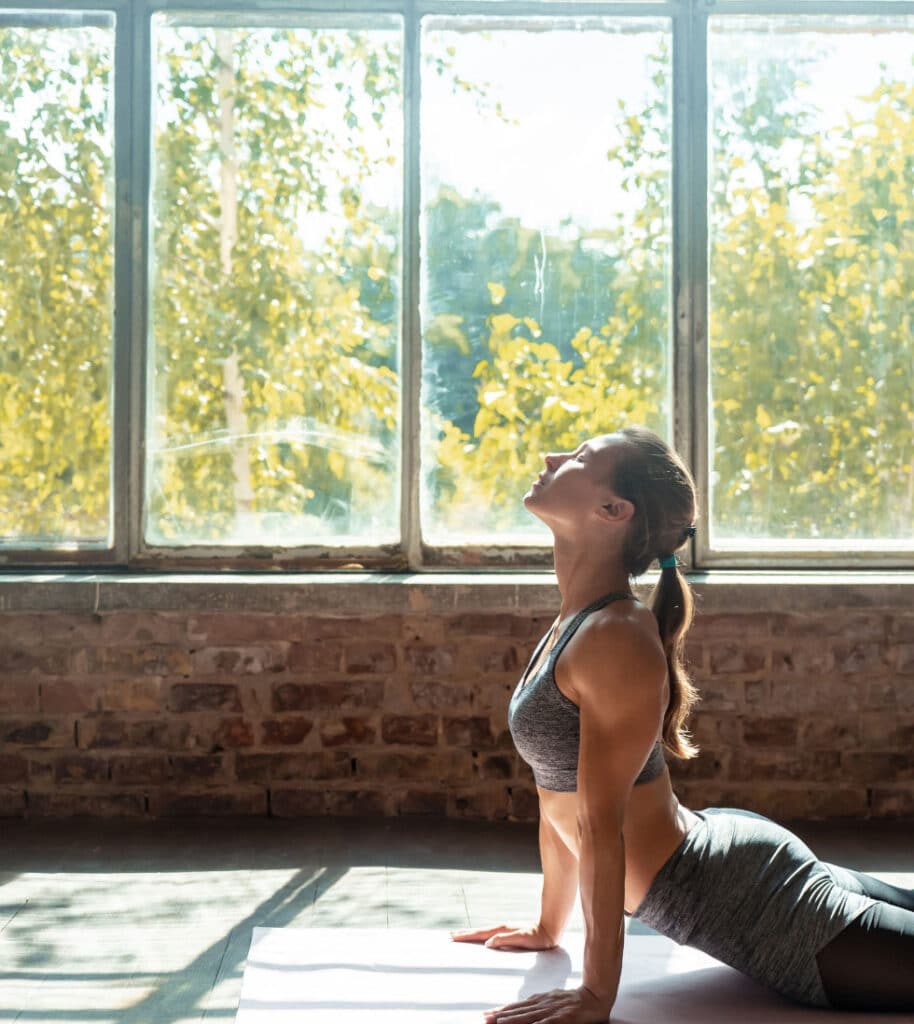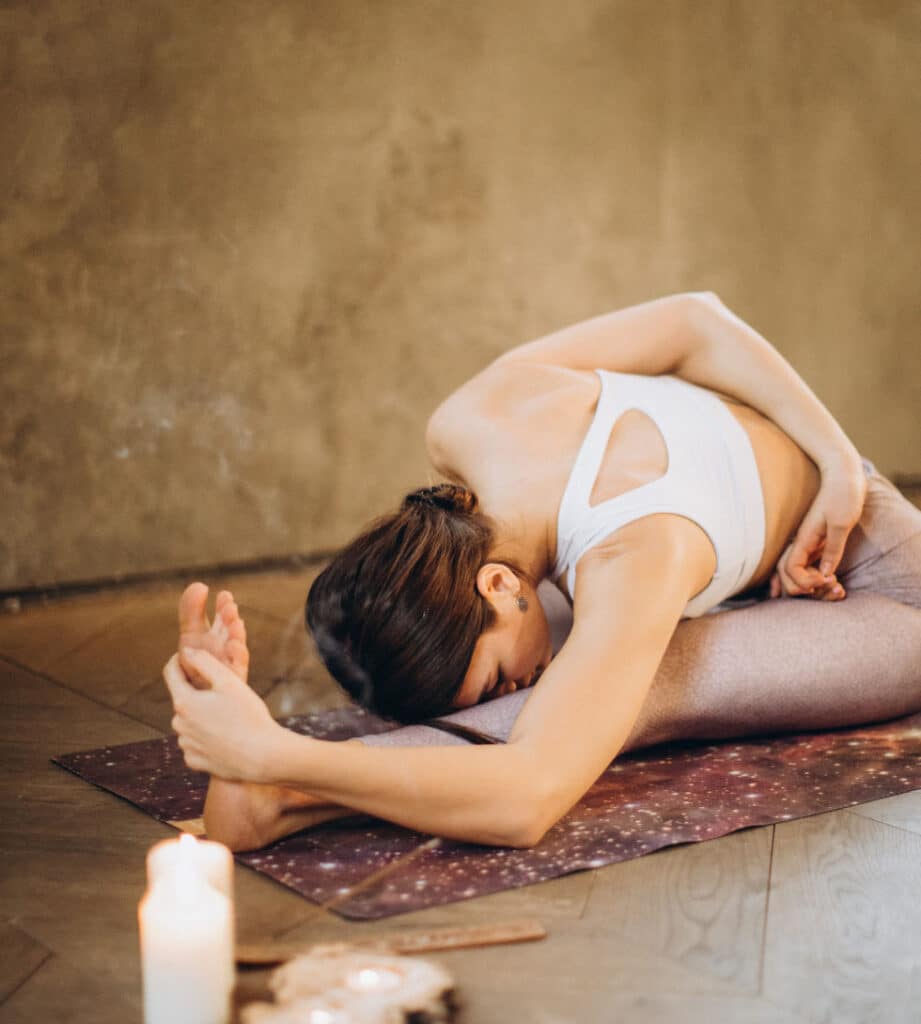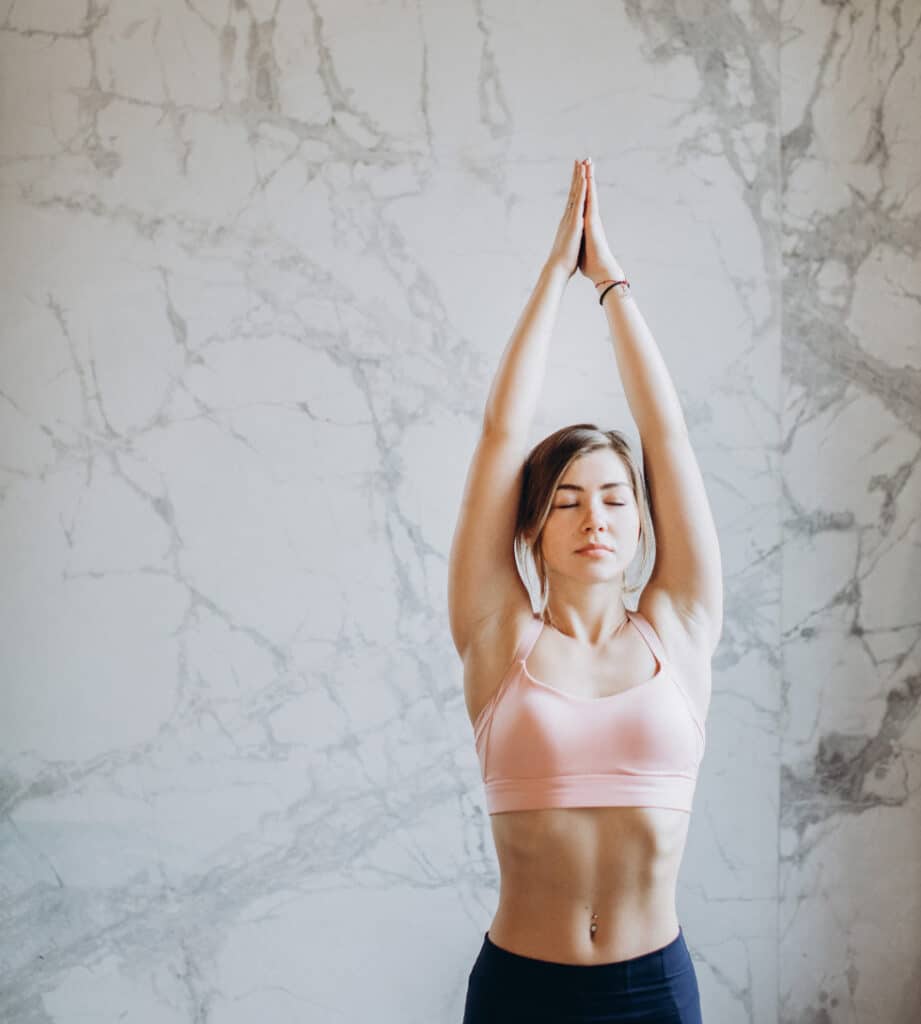
Yoga, Definition of an Ancient Practice
Yoga is an age-old discipline, simultaneously physical, mental, and spiritual, with its roots deep in India.
It’s not just a practice; it’s a way of life that advocates harmony between the body, mind, and the universe.
Focusing on the Ayurvedic symbiosis between body and mind, yoga involves postures (asanas), breathing techniques (pranayama), and meditation.
Regular yoga practice provides a deeper understanding of one’s body, strengths, and limits.
The Principles of Yoga
Yoga is built upon several fundamental pillars that, when adhered to, lead to optimal results:
Breath as the bridge between body and mind.
Yoga posture, called Asana, to strengthen the body and enhance flexibility.
Intense concentration to perform each posture with precision.
Relaxation through meditation, to soothe the mind and reduce stress.
Unity between the body, mind, and the surrounding universe.


The Benefits of Yoga
Yoga can be tailored to individual needs, whether for recovery after an injury, improvement of overall health, or enhancement of physical fitness.
Body Balancing: Yoga asanas are designed to strengthen various muscle groups, promoting balance and body stability.
Increased Flexibility: Yoga includes stretches that help improve flexibility and joint mobility.
Stress Management: Meditation and controlled breathing aid in stress management and calming the mind.
Posture Correction: Regular practice helps correct posture, alleviating pain associated with poor postural habits.
A tailor-made method
Yoga is a discipline that can be practiced by everyone, regardless of age, gender, or fitness level. Sessions can be individual or in a group, targeting practices such as prenatal yoga, children’s yoga, integral yoga, dynamic yoga, and more.
Learning yoga is tailored to meet the specific needs of each individual, whether it’s relieving chronic pain, improving mobility, or simply getting back in shape.
It can be practiced in a studio, at home, with an individual instructor, in person, or through video sessions. There’s no need for expensive equipment to practice yoga and meditation.
Discover ourhome Pilates lessons service.

Pilates & Yoga
A beneficient synergy to revitalize your body and mind
Movements to enhance your energy and tone your body
Definition
Meditation, flexibility, and care for the mind, body, and soul.
Strengthening all muscle groups, correcting posture, and relieving chronic pain or muscle tension.
Objective
Enhancing flexibility, muscle strength, relaxation, and mental well-being.
Concentration, Strength, Breathing, Control, and Fluidity of Movement.
Method
Postures, Breathing, Concentration, Relaxation, Meditation.
Body, physical well-being, and pain relief.
Benefits
Harmony of body and mind, mobility, relaxation, and overall well-being.
Yoga session at home
Questions & Answers
Yoga is tailored to meet the specific needs of each individual, whether it’s harmonizing body and spirit, improving mobility, or simply getting back in shape.
Yoga is a discipline that can be practiced by everyone, regardless of age, gender, or fitness level. Sessions can be individual or in a group.
It is recommended to consult a healthcare professional before engaging in any physical activity.
The practice of yoga at home is gaining popularity, and for good reasons. It offers a variety of advantages that can transform your yoga experience.
Here are some reasons to choose home yoga classes:
Customized Classes: With a dedicated yoga instructor at home, each class can be tailored to your specific needs. Whether you are looking to start yoga or deepen certain yoga postures, private yoga instruction allows progression at your own pace.
Comfort and Privacy: Practicing yoga at home means enjoying a yoga session in your living room or any chosen room. No need to transport your yoga mat across the city; everything happens in your personal space.
Promotes Letting Go: Practicing yoga in your familiar environment helps achieve a state of serenity more quickly. The union of yoga and meditation finds its power when practiced without external distractions and in a familiar atmosphere.
Flexible Schedule: Home yoga sessions allow you to adapt to your timetable. Whether for weekly classes or occasional sessions, flexibility is key.
Bringing your yoga studio into your apartment or house provides an enhanced experience, both in terms of teaching quality and the comfort of being at home.
Opting for yoga sessions in your personal cocoon is a decision that prioritizes well-being and peace of mind.
The world of Yoga may seem vast and a bit intimidating for beginners, but don’t worry, we’re here to help you understand the basics of a few main types of yoga.
Hatha Yoga: Often considered the foundational yoga, it blends postures (asanas), breathing exercises (pranayama), and sometimes chanting or body purification techniques. It’s gentle, focusing on learning and mastering each posture while breathing correctly. It helps you feel more grounded and balanced, as if your feet are firmly planted on the ground.
Iyengar Yoga: This style delves deeper into the details of postures. It’s very precise, emphasizing perfect alignment. Props like blocks or straps may be used to help position your body correctly.
Vinyasa Yoga: Similar to dance choreography, Vinyasa involves fluid movement from one posture to another, following the rhythm of your breath. It’s a more dynamic and active style, allowing you to move and expend energy.
Kundalini Yoga: This practice aims to awaken the dormant life force believed to be at the base of our spine. It uses a combination of postures, chanting, breathing, and meditation. Kundalini Yoga can help you feel more alive and aware of your body and mind.
Ashtanga Yoga: A more rigorous style, akin to a high-intensity workout It includes a specific series of postures that must be performed in a precise order. Ashtanga demands discipline, strength, and flexibility.
With the variety of available yoga styles, choosing the one that suits you best might seem complex.
To start off on the right foot, identify your goals:
- If you’re looking for a gentle introduction to the world of yoga, Hatha Yoga is an excellent starting point.
- If you prefer a practice centered on perfect alignment and precision, Iyengar Yoga might be the ideal choice.
For those seeking a dynamic and active flow, Vinyasa Yoga is perfect. - If your quest is more spiritual, aiming to awaken inner energy, Kundalini Yoga would be suitable.
- For athletes looking to challenge themselves, Ashtanga Yoga offers a rigorous sequence.
If you’re availing yourself of our exclusive private Pilates and Yoga classes at home, our expert instructors will assess your needs, preferences, and individual goals to recommend the yoga style that suits you best.
You don’t have to navigate this path to well-being alone; we’re here to guide you every step of the way.
Home sessions can be booked by phone or through our contact form.
We will assess your needs together and ask you to provide information about any health conditions to ensure your comfort and safety.
Sessions can be modified or refunded up to 48 hours in advance. Any modification or cancellation must be notified via email at info@pilates-excellence.com.
It is not necessary to choose between yoga and Pilates, as these two methods complement each other.
Yoga primarily focuses on harmony between body and mind, flexibility, relaxation, and meditation, while Pilates places more emphasis on strengthening deep muscles.
However, it is also possible to combine both methods to enjoy the benefits of each. The choice between yoga and Pilates depends on personal preferences and individual goals.
Are you torn between an online session and home one?
Contact us at +33 (0)6 73 34 15 29 or through our contact form.
We’ll advise you based on your needs and expectations, taking the time to determine the session format and the instructor who will best accompany you.
Engaging in yoga caters to a myriad of needs and concerns, spanning the realms of physical, emotional, spiritual, and mental well-being.
Physical Needs:
- Muscle Strengthening: Yoga postures target various muscle groups, facilitating comprehensive and balanced body strengthening
- Flexibility: Yoga stretches and elongates muscles, enhancing flexibility and reducing the risk of injuries.
- Posture Improvement: Yoga heightens awareness of body alignment, aiding in correcting postural imbalances.
- Immune System Stimulation: Certain poses stimulate lymphatic circulation, promoting enhanced immunity.
Emotional Needs
- Stress and Anxiety Reduction: The combination of deep breathing and yoga postures promotes relaxation and reduces stress levels.
- Emotional Balance: Regular meditation and yoga practice help manage emotions and foster greater serenity.
- Increased Self-Confidence: Overcoming challenges posed by certain poses builds confidence in one’s abilities.
Spiritual Needs
- Self-Connection: Yoga provides a space for reflection and introspection, facilitating a deeper understanding of oneself.
- Spiritual Awakening: For many, yoga serves as a path to discovering or deepening their spirituality.
- Sense of Community and Individuality: Group practice, whether in classes or retreats, fosters connections and shared experiences. For home yoga classes, it’s an excellent way to center oneself and find one’s place in the universe.
Mental Needs
- Improved Concentration: Meditation and concentration techniques inherent in yoga enhance attention and mental clarity.
- Resilience Development: Regular practice cultivates better resilience in facing challenges and adversities.
- Yoga offers a holistic approach, addressing the entirety of the human experience and catering to a multitude of needs at various conscious and subconscious levels.
A home yoga session typically commences with a warm-up, incorporating breathing exercises and simple postures to prepare the body and mind.
The session gracefully progresses with a sequence of refined asanas, executed with concentration and precision, activating and strengthening various muscle groups.
Elegantly concluding, the session often features a period of relaxation and meditation, fostering tranquility for both body and mind.
Throughout the session, the Yoga instructor may provide articulate verbal instructions to guide movement, along with subtle physical corrections to maintain impeccable posture and alignment. Additionally, bespoke modifications for exercises may be suggested to cater to the individual needs of participants. Ready for this journey into refined well-being?
Newsletter
Receive our tips, news and updates once a month in your mailbox
